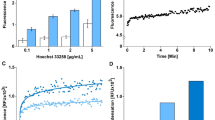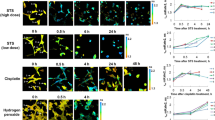Abstract
The intracellular distribution of glutathione (GSH) was measured by a quantitative image cytometry method, using the sulphydryl-reactive agent mercury orange. This readily forms fluorescent adducts with GSH and other non-protein sulphydryls (NPSH), but reacts much more slowly with protein sulphydryls. Under optimum staining conditions mean integrated mercury orange fluorescence per cell was closely correlated with a standard biochemical assay for GSH. Use of the DNA dye DAPI as a counterstain allowed measurement of nuclear NPSH. The mean nuclear-cytoplasmic ratio was 0.57 +/- 0.05. Isolation of nuclei under aqueous conditions resulted in the loss of approximately 90% of mercury orange fluorescence, compared with nuclear fluorescence from intact cells, suggesting that background labelling of protein sulphydryls or other macromolecules is low. Depletion of GSH with N-ethylmaleimide or diethylmaleate decreased mercury orange fluorescence in the nucleus and cytoplasm to a similar extent. In contrast, mercury orange fluorescence in the nucleus was much more resistant to DL-buthionine-S,R-sulphoximine (BSO) depletion than that in the cytoplasm. This finding is compatible with a distinct pool of GSH in the nucleus that is comparatively resistant to BSO depletion. Alternatively, the retention of fluorescence in the nucleus following GSH depletion by BSO treatment might be due to accumulation of cysteine. These findings have implications for cancer treatment since the level of NPSH in the nucleus might be a more important determinant of resistance to DNA-damaging agents than that in cytoplasm. The image cytometry method described here is quantitative, allows a measure of tumour cell heterogeneity and can be applied to small biopsy samples obtained by fine-needle aspiration. Thus it appears suitable for prospective clinical studies in cancer patients, and for monitoring the effects of GSH-depleting agents used as adjuncts to cancer chemotherapy or radiotherapy.
This is a preview of subscription content, access via your institution
Access options
Subscribe to this journal
Receive 24 print issues and online access
$259.00 per year
only $10.79 per issue
Buy this article
- Purchase on Springer Link
- Instant access to full article PDF
Prices may be subject to local taxes which are calculated during checkout
Similar content being viewed by others
Author information
Authors and Affiliations
Rights and permissions
About this article
Cite this article
Thomas, M., Nicklee, T. & Hedley, D. Differential effects of depleting agents on cytoplasmic and nuclear non-protein sulphydryls: a fluorescence image cytometry study. Br J Cancer 72, 45–50 (1995). https://doi.org/10.1038/bjc.1995.275
Issue Date:
DOI: https://doi.org/10.1038/bjc.1995.275
This article is cited by
-
Arabidopsis mutants impaired in glutathione biosynthesis exhibit higher sensitivity towards the glucosinolate hydrolysis product allyl-isothiocyanate
Scientific Reports (2018)
-
Association between tissue hypoxia and elevated non-protein sulphydryl concentrations in human cervical carcinoma xenografts
British Journal of Cancer (1999)



